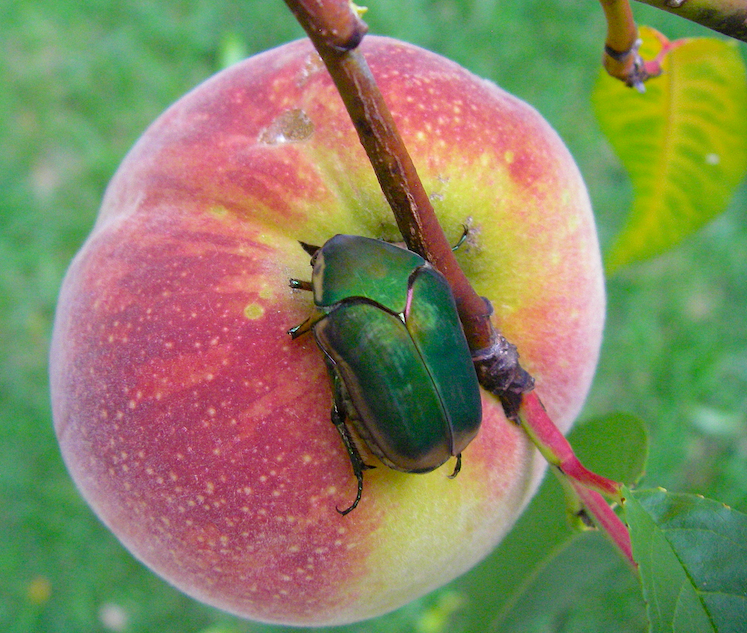The Green June Beetle, scientifically known as Cotinis nitida, is a vibrant insect native to the United States and Canada, particularly noticeable in Georgia.
They are characterized by their striking green coloration with possible rusty brown, golden, or bright orange stripes.
These beetles are a common sight during the summer months.
Typically ranging from half an inch to an inch in length, Green June Beetles are often confused with similar species like the Japanese beetle, yet they possess distinct physical and behavioral traits.
These beetles embark on their flight in late June, earning them their moniker.
They play a dual role in their ecosystems, contributing to soil aeration through tunneling activities.
Yet, they can also threaten agriculture by damaging plant roots and feasting on ripe fruits.
This introduction will explore the green June Beetle diet, fascinating lifecycle, behavior, ecological impact, and management.
The residents of the US & Canada, and especially from Georgia, surely would know about these green Beetles.
This write-up will briefly describe these Green Beetles, including their physical aspects, life cycle, behavior, the damage they can cause, and how to curb their growth.
Overview of Green June Beetles
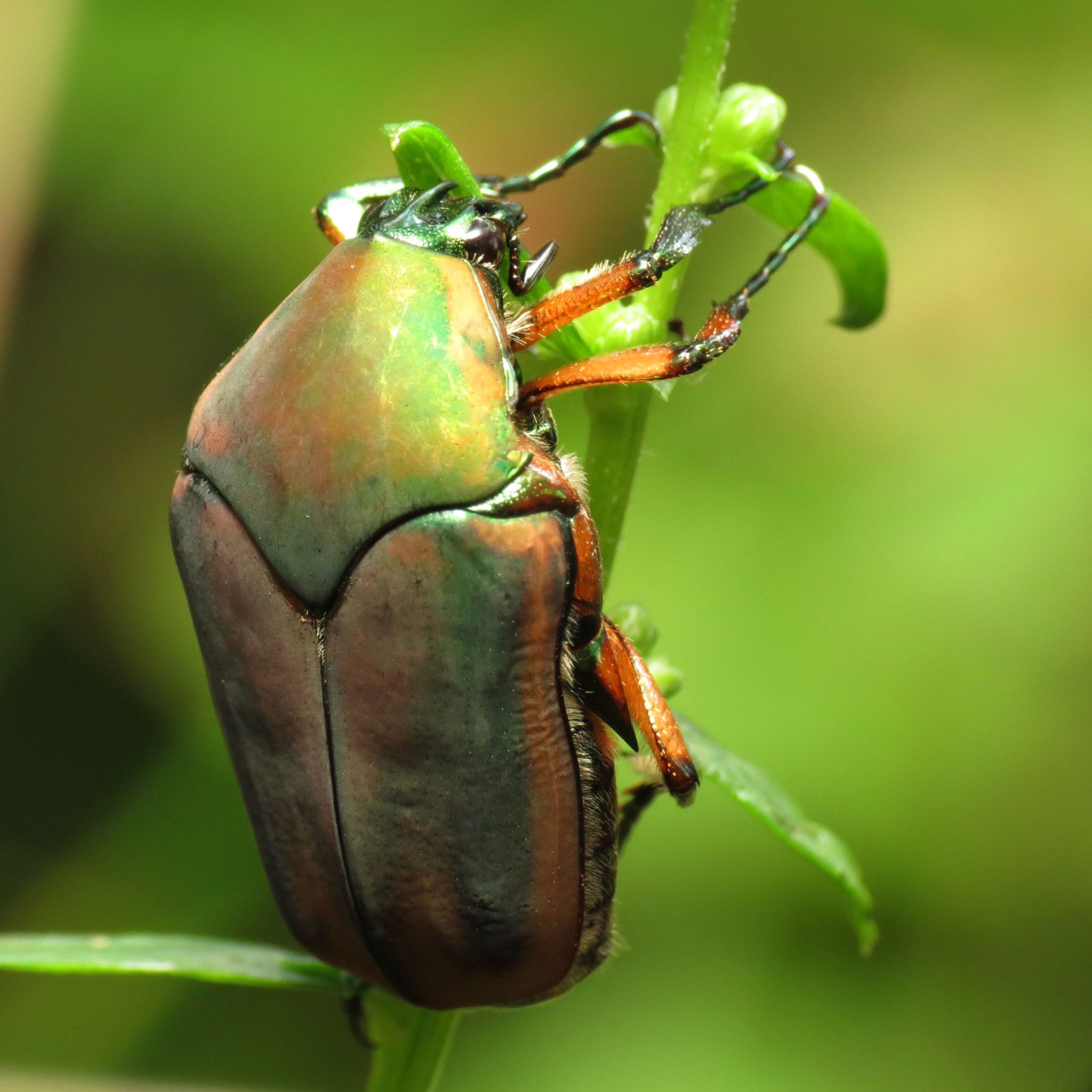
With a very common name, Green June Beetles are also known by their scientific name, Cotinis nitida.
In layman’s language, it is usually called June Beetles. These green beetles are green in color and thus called Green June Beetles.
They can have colorful stripes over their body or wing covers. Usually, they have the color rusty brown, slightly golden, or bright orange.
These green beetles are hardly an inch long. Smaller ones can be about half an inch in size.
People often get confused between the Japanese beetle & the green June beetle. The Japanese beetle is also green in color with brownish color wing covers.
The Japanese beetle differs from the green June beetle and can be easily identified by size. Japanese beetles are smaller in size.
These green beetles are also confused with the bumble flower beetles, as both species crawl on their backs.
However, the bumbleflower beetles do not cause much damage.
Lifecycle of Green June Beetles
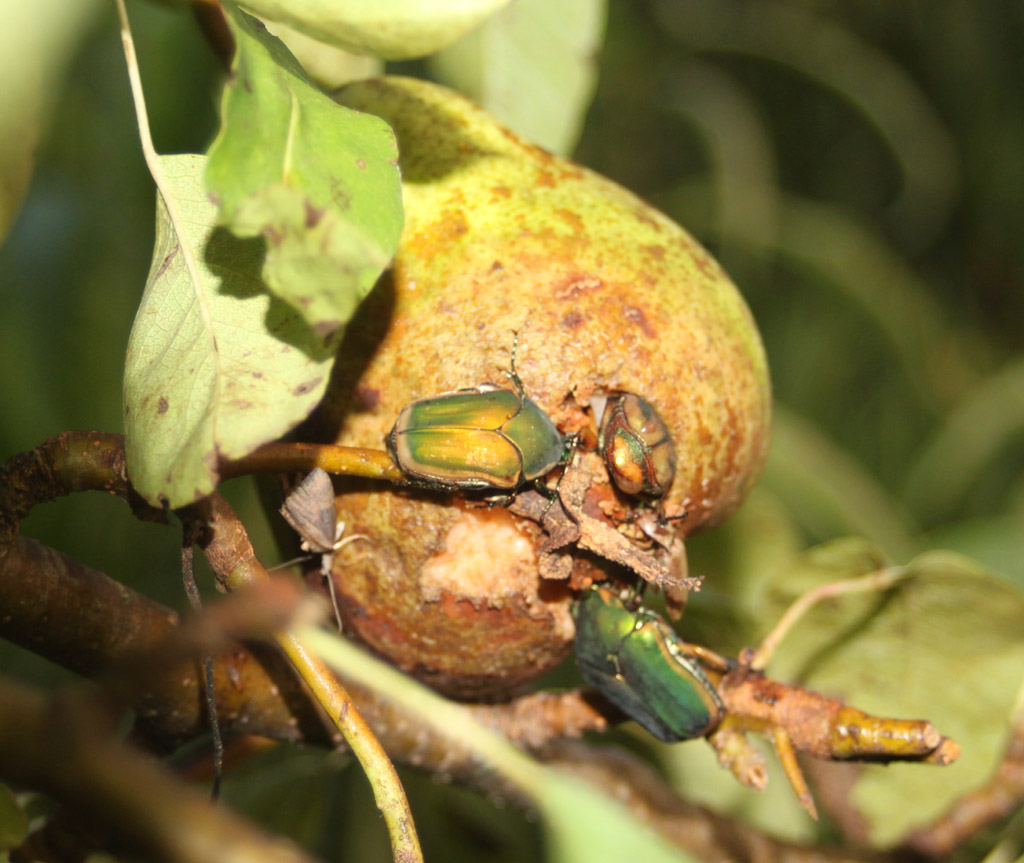
The lifecycle of these green beetles is eggs, larvae, pupae & ultimately adult green beetles.
Ultimately, fully grown adult green beetles (grub worms) usually reside in loamy soils.
The life cycle of these green beetles is one year.
1. Eggs
Once the mating process between the male & female is completed, the female makes a burrow in the soil and places around 50 to 75 eggs. The eggs have a hatching period of 2 weeks.
The eggs are white in color & elliptical in shape. After 2 weeks, these eggs start becoming spherical & eggs hatch into larvae.
2. Larva
In the larval stage, these insects are initially white and can grow up to 1.5 inches.
Slowly, they start developing heads & spiracles that are brown. During the stage of larvae, the color slowly changes to green.
The larva ultimately develops a brown head & three pairs of legs. They crawl on their backs.
The legs have no particular use in crawling and are in the air. This is a unique distinction of the green June beetle larvae.
Larva feeds on manure, organic matter, mold, compost & humus. Larvae mainly damage the roots of the plants.
Particularly, the larva damages the plants that have been raised over fertilizers & mulch.
The larval stage of the green June beetle is more dangerous than the adult green beetle.
3. Pupa
The pupa stage lasts 18 days until it becomes an adult green beetle. The pupa is in the form of a cocoon.
The cocoon is produced during larval when the larva produces a thick, viscous fluid. A cocoon is built by dirt, dust & soil particles.
The viscous fluid helps in the formation of the cocoon. The shape of the cocoon is oval.
When the pupa is converted into an adult beetle, it slowly develops a green color.
4. Adult Green Beetle
Adult Green Beetles shrink in length when compared to their larva. They are around half an inch to an inch in length & around half an inch in width.
Now, the insect fully justifies its name of green beetle. Adult green beetles usually eat rotten fruits.
These fruits are grapes, oranges, berries, apples, apricots, plums, pears, and many more.
These green beetles can be notorious as they can feed on the sap of maple, oak, and other trees.
The adult green beetle starts their flight in late May & continues till early August, with the most flight time occurring in June & July.
Damaging Stage & Time of Green June Beetles
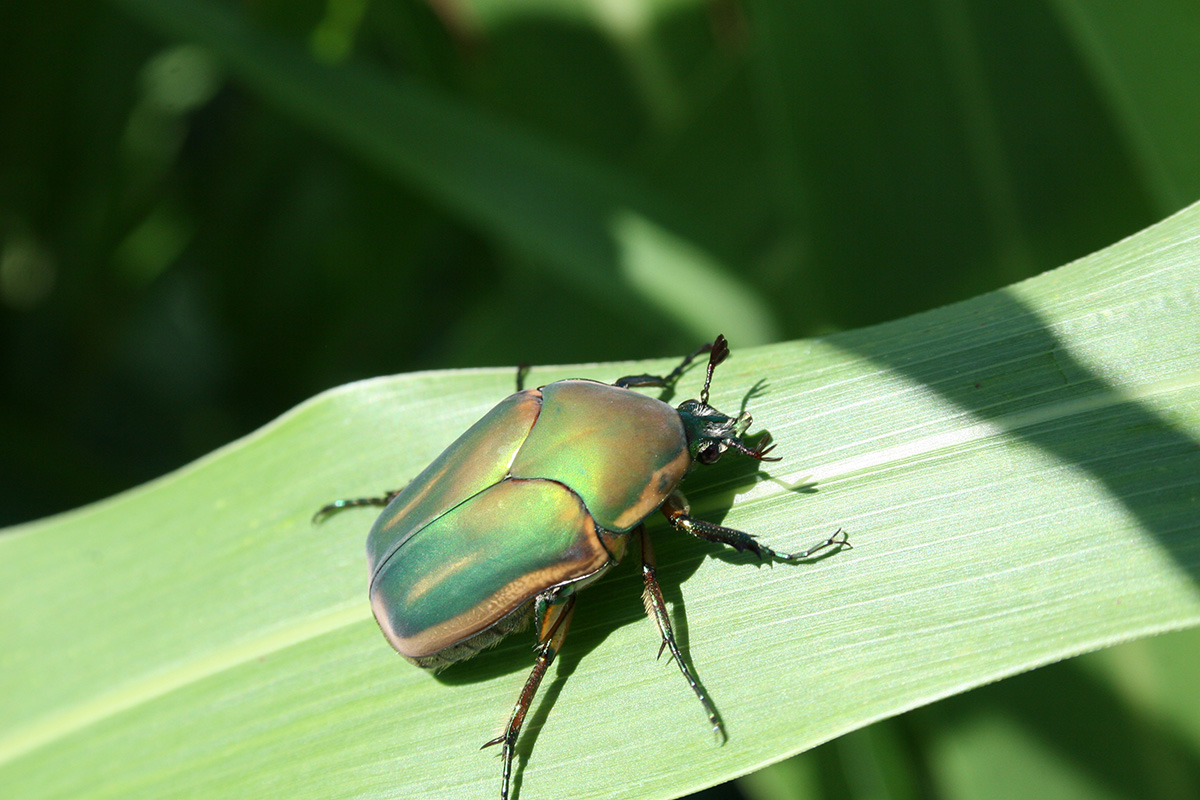
Larva & Adult green beetles usually cause the damage. The damages by the larval stage are during the late summer till the fall & again in the spring.
These insects become more & more dangerous when the temperature rises beyond 22°C or around 70°F.
During the warm winters, these grubworms come out of the soil, leaving their trail. Also, apart from the trails of tunnels, they form mounds of soil.
These indications increase during the spring.
After their feast, the mature lava enters the soil again and starts to pupate in the late spring.
They arise as adult beetles in mid to late June & live until late August & early October. The tunnels can be around the size of one’s finger.
Mating & Hatching of Green June Beetles
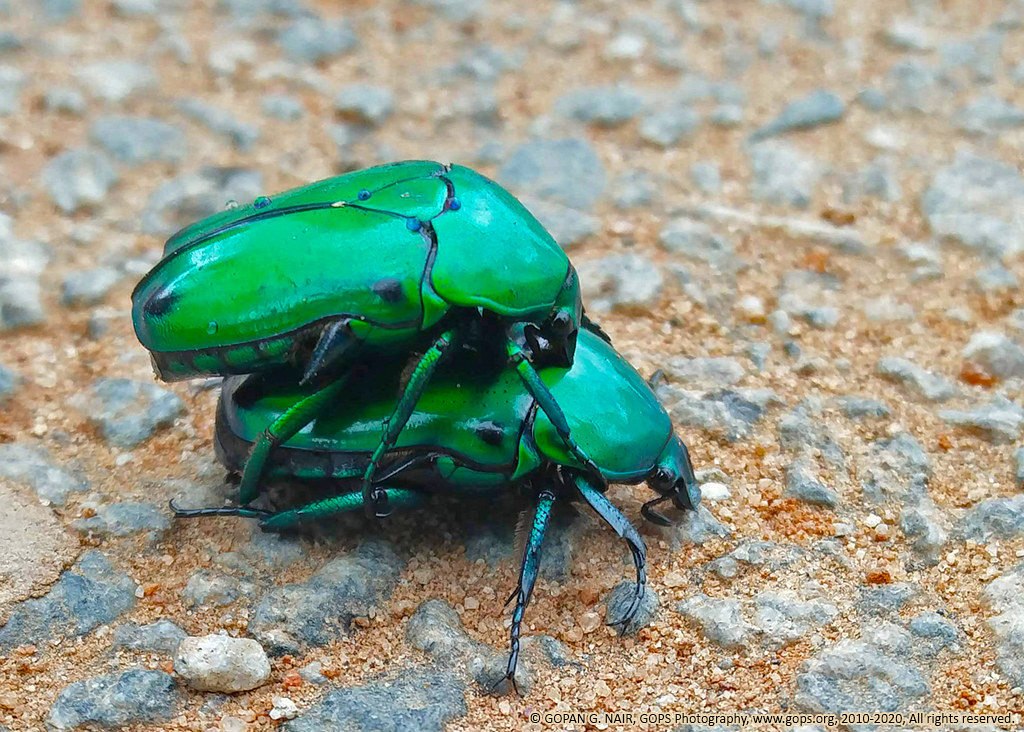
Female green beetles travel & settle near the grass surfaces. These female green beetles release some chemicals which attract the male green beetles.
The male beetles track these chemicals & reach the female green beetles.
The female green beetle comforts itself in a safe place & mating occurs. Once the mating occurs, the female green beetle finds a comfortable grassy & moist area.
It selects a place where the soil contains high amounts of organic matter.
The female green beetle then digs a hole in the soil & prepares a small ball of soil. It then lays its eggs in this small ball of soil.
The ball of soil is burrowed around 7 inches deep into the soil.
The hatching period of the eggs is around 2 weeks. A female green beetle can lay around 60-75 eggs after mating.
Once the eggs break open, the young larvae start digging for organic matter.
Managing the Green June Beetle Populations
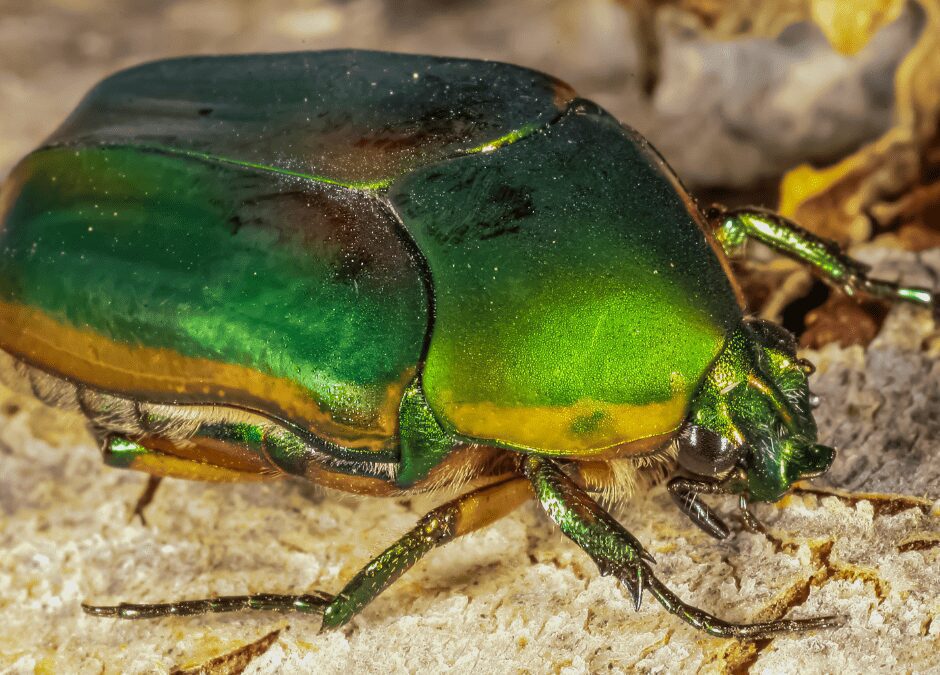
To effectively manage Green June Beetle populations and mitigate their potential damage, adopting an integrated pest management (IPM) approach is crucial.
This strategy combines environmentally friendly and sustainable practices to control beetle populations, minimizing reliance on chemical insecticides.
1. Cultural Practices
Cultural practices form the backbone of IPM by altering the environment to make it less hospitable for pests:
- Soil Management: Regular soil cultivation and aeration can disrupt the beetles’ lifecycle by exposing larvae to predators and reducing soil compaction, which can deter females from laying eggs.
- Sanitation: Removing fallen fruits and decaying plant matter from the area can significantly reduce food sources for adult beetles, thus lowering their population.
- Proper Irrigation: Overwatering can create favorable conditions for beetle larvae. Maintaining optimal moisture levels in the soil can discourage beetle proliferation.
2. Biological Control
Leveraging natural enemies of the Green June Beetle can provide effective control without the adverse effects of chemicals:
- Parasitic Wasps: Encouraging or introducing parasitic wasps like *Scolia dubia* can help control beetle populations as these prey on the larvae.
- Nematodes: Beneficial nematodes, such as *Heterorhabditis* and *Steinernema* species, can be applied to the soil to infect and kill beetle larvae without harming plants.
- Birds and Mammals: Promoting a habitat friendly to birds, moles, and skunks can help reduce beetle populations as these animals feed on the larvae and adults.
3. Preventive Measures
Preventive measures can reduce the likelihood of beetle infestations:
- Crop Rotation and Diversity: Rotating crops and planting a diversity of species can disrupt the lifecycle of the beetles and reduce the likelihood of large infestations.
- Barrier Methods: Using row covers or netting can physically prevent beetles from accessing plants during peak activity periods.
4. Chemical Control as a Last Resort
While chemical controls are effective, they should be used judiciously and as a last resort due to potential environmental impacts:
- Targeted Insecticides: If chemical control is necessary, opt for targeted insecticides that have minimal impact on non-target species. The application should be timed to coincide with early larval stages for maximum effectiveness.
- Insecticidal Soaps and Neem Oil: For less severe infestations, organic options like insecticidal soaps and neem oil can provide control with lower environmental impact.
5. Monitoring and Thresholds
Regular monitoring of beetle populations and damage levels is crucial for IPM.
Establishing action thresholds can help determine when intervention is necessary, allowing for using control methods in a more targeted and efficient manner.
By integrating these strategies, gardeners and farmers can effectively manage Green June Beetle populations, preserving plant health while maintaining ecological balance.
Final Thoughts
In conclusion, Green June Beetles, scientifically known as Cotinis nitida, are notable for their distinctive green coloration and presence across the US and Canada, particularly in regions like Georgia.
Their lifecycle, from eggs to larvae, pupae, and adults, is intricately linked with the soil environment, especially areas rich in organic matter.
While the larvae can cause significant damage to plant roots due to their feeding habits, adult beetles are more of a nuisance when they feed on ripe fruits and damage foliage.
Despite their potential for harm, these beetles also play a role in soil aeration and decomposition.
Effective management strategies, primarily through targeted insecticide use and cultural practices, can mitigate their impact.
It’s crucial to balance control measures with ecological considerations, ensuring that interventions do not inadvertently harm beneficial soil organisms or the broader ecosystem.
Frequently Asked Questions
Why Are These Green Beetles Called June Beetles?
These green beetles start their flight around the later phase of June, hence the name of June’s beetles.
They are also known as June bugs or June beetle grubs. The fully grown adult Green June Beetles are also called Grub worms.
These grubs are very common in the soil. These green beetles usually prefer soil with plenty of organic matter. Green June’s beetles usually prefer sandy soil.
How Do Tunneling and Mounds by Green June Beetles Affect the Environment?
Some experts say limited tunneling can be beneficial, whereas excess can hamper soil quality. Soil is aerated due to the tunneling of these green beetles.
Excess of it can loosen the soil & damage the plant roots. These green beetles also have a knack for leaving small mounds of soil near the tunnel.
In the process of tunneling, they also leave their trail.

